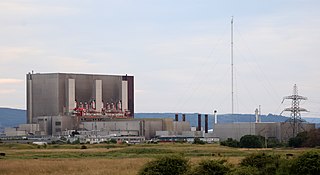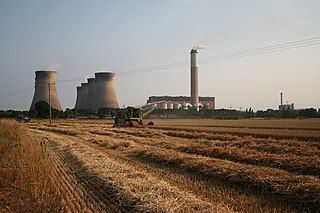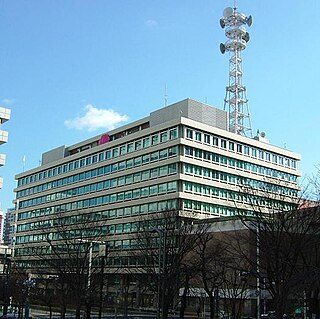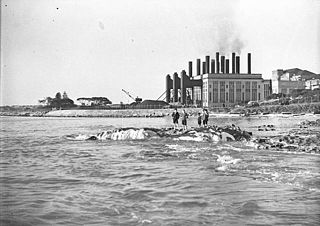
Bankside Power Station is a decommissioned electricity generating station located on the south bank of the River Thames, in the Bankside area of the Borough of Southwark, London. It generated electricity from 1891 to 1981. It was also used as a training base for electrical and mechanical student apprenticeships from all over the country. Since 2000 the building has housed the Tate Modern art museum and gallery.

Inverkip power station was an oil-fired power station on the Inverclyde coast, Firth of Clyde, west coast of Scotland. It was closer to Wemyss Bay than Inverkip, and dominated the local area with its 236 m (774 ft) chimney, the third tallest chimney in the UK and Scotland's tallest free-standing structure. In common with other power stations in Scotland it lacked cooling towers; instead, sea water was used as a coolant. The station consisted of three generating units with a combined total rating of 2028 megawatts (MW).

Hartlepool nuclear power station is a nuclear power station situated on the northern bank of the mouth of the River Tees, 2.5 mi south of Hartlepool in County Durham, North East England. The station has a net electrical output of 1,185 megawatts, which is 2% of Great Britain's peak electricity demand of 60 GW. Electricity is produced through the use of two advanced gas-cooled reactors (AGR). Hartlepool was only the third nuclear power station in the United Kingdom to use AGR technology. It was also the first nuclear power station to be built close to a major urban area.

EDF Energy is a British integrated energy company, wholly owned by the French state-owned EDF, with operations spanning electricity generation and the sale of natural gas and electricity to homes and businesses throughout the United Kingdom. It employs 11,717 people, and handles 5.22 million business and residential customer accounts.

Poolbeg Generating Station, colloquially known as The Poolbeg Stacks, is a power station owned and operated by the Electricity Supply Board of Ireland (ESB). There are two stations on the site, the older thermal station containing units 1, 2, and 3 and the combined cycle gas station containing units CG14, CG15 and ST16, which is located toward the eastern end of the site. The six units have a total installed capacity of 1020 MW.

Niederaussem Power Station is a lignite-fired power station in the Bergheim Niederaussem/Rhein Erft circle, owned by RWE. It consisted of nine units, which were built between 1963 and 2003. It is the largest lignite coal power plant in operation in Germany, with total net capacity of 2,220 MW. The plant is estimated to have been one of the ten most carbon-polluting coal-fired power plants in the world in 2018, at 27.2 million tons of carbon dioxide, and its emissions intensity is estimated to be 45.1% higher relative to the average for all fossil-fueled plants in Germany. According to the study Dirty Thirty, issued in 2007 by the WWF, Niederaussem Power Station is the second-worst power station in Europe in terms of mercury emissions due to the use of lignite.

Eggborough power station was a coal-fired power station in North Yorkshire, England, which was capable of co-firing biomass. It was situated on the River Aire, between the towns of Knottingley and Snaith, deriving its name from the nearby village of Eggborough. The station had a generating capacity of 1,960 megawatts, enough electricity to power 2 million homes, equivalent to the area of Leeds and Sheffield.

Cottam power station is a decommissioned coal-fired power station. The site extends over 620 acres (250 ha) of mainly arable land and is situated at the eastern edge of Nottinghamshire on the west bank of the River Trent at Cottam near Retford. The larger coal-fired station was decommissioned by EDF Energy in 2019 in line with the UK's goal to meet its zero-coal power generation by 2025. The smaller in-use station is Cottam Development Centre, a combined cycle gas turbine plant commissioned in 1999, with a generating capacity of 440 MW. This plant is owned by Uniper.

Chubu Electric Power Co., Inc., abbreviated as Chuden in Japanese, is a Japanese electric utilities provider for the middle Chūbu region of the Honshu island of Japan. It provides electricity at 60 Hz, though an area of Nagano Prefecture uses 50 Hz. Chubu Electric Power ranks third among Japan's largest electric utilities in terms of power generation capacity, electric energy sold, and annual revenue. It is also one of Nagoya's "four influential companies" along with Meitetsu, Matsuzakaya, and Toho Gas. Recently, the company has also expanded into the business of optical fibers. On January 1, 2006, a new company, Chubu Telecommunications, was formed.

Bunnerong Power Station was a coal-fired power station in the south-eastern Sydney suburb of Matraville, New South Wales, Australia that was decommissioned by 1975 and subsequently demolished. When the last generating units were commissioned, it was the largest power station in the southern hemisphere, with a capacity of 375 megawatts (MW) from eleven turbo-alternators. It was able to supply up to one third of the state's electricity needs at the time. It remained the most powerful until the completion of Vales Point Power Station in 1966.

Barking Power Station refers to a series of power stations at various sites within the London Borough of Barking and Dagenham in east London. The original power station site, of the coal-fired A, B and C stations, was at River Road, Creekmouth, on the north bank of the River Thames. These stations were decommissioned by 1981 and were subsequently demolished. The later gas-fired power station was built further down the Thames near Dagenham Dock in the early 1990s. The site of the former power stations is being redeveloped as Barking Riverside.

The New Plymouth Power Station (NPPS) was a 600 MW thermal power station at New Plymouth, New Zealand, that operated from 1974 to 2008. Located at Port Taranaki, it was dual fuelled on natural gas and fuel oil. Constructed at a time of major hydro and HV transmission developments, it was New Zealand's first big thermal power station planned for continuous baseload operation.

Great Yarmouth Power Station is combined cycle gas turbine power station on South Denes Road in Great Yarmouth in Norfolk, England, with a maximum output of 420 MW electricity, opened in 2001. It is built on the site of an oil-fired power station, built in 1958 and closed and demolished in the 1990s. A coal-fired power station was built in Great Yarmouth in 1894 and operated until 1961. The station is operated by RWE.
Romania is the 38th largest energy consumer in the world and the largest in South Eastern Europe as well as an important producer of natural gas, oil and coal in Europe.

As of April 2020, the energy sector in Senegal has an installed capacity of 1431 megawatts (MW). Energy is produced by private operators and sold to the Senelec energy corporation. According to a 2020 report by the International Energy Agency, Senegal had nearly 70% of the country connected to the national grid. Current government strategies for electrification include investments in off-grid solar and connection to the grid.
The Sendou power station is a coal-fired power station in Senegal. The power plant, located near Bargny, is currently in operation and will be transformed to a natural gas-fired power station in the near future.

Kashima Power Station is a large oil-fired and gas-fired power station in Kamisu, Ibaraki, Japan. The facility operates with an installed capacity of 5,660 MW, making it one of the largest fossil-fueled power station in the world. The plant includes four oil-fired steam turbines rated at 600 MW, two oil-fired steam turbines rated at 1,000 MW, and three advanced combined cycle gas turbines rated at 420 MW added in 2014. As of April 2016, the four oil-fired 600 MW turbines have been suspended indefinitely. The plant features 3 lattice stacks, including the tallest steel chimney in the world at 231m. In March 2023, JERA announced plans to decommission all six oil-fired steam turbines.

The Tracy Thermal Generating Station is a retired 660-megawatt heavy fuel oil-fueled thermal power station built from 1962 by the Shawinigan Water & Power Company and completed by Hydro-Québec after the buyout of all private electric utilities by the government of Quebec in 1963. Commissioned between 1964 and 1968, the plant is located on the banks of the Saint Lawrence River in the city of Sorel-Tracy, in the Montérégie Region.

The thermal power plant of Vouvry, also known as the Chavalon Plant, is a former power station located in the municipality of Vouvry, in the canton of Valais, Switzerland. Until its closure in 1999, the plant utilized heavy fuel oil, combusted to heat a steam generator. The vaporized water then drove a turbine, which powered an alternator.

The Ronchampthermal power station is a coal-fired power plant near the Chanois coal mine in the town of Ronchamp, Haute-Saône, in the French region of Bourgogne-Franche-Comté.



















